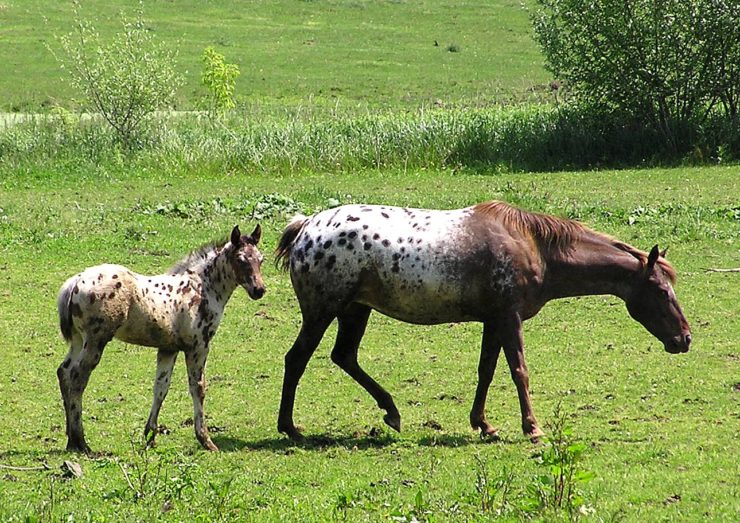These are difficult times, and anxiety levels are off the charts. But there is hope in the world, however obscured it may be by the human catastrophe. It’s spring in the Northern Hemisphere, after all, and the world is rejuvenating, with or without us. In the horse world, that means: Baaaaaby Horses!
Cute. Fuzzy. Relatively little compared to their adult form. And in fiction, as in real life, they offer lots of potential for drama and romance. There’s nothing like a good (or bad-turned-to-good-by-heroic-save) foaling scene for spicing up a story.
This, for the mare and her anxious breeder-owner-manager, is the culmination of almost a year of waiting and hoping. The mare is in charge, however much the humans may think they are. Under normal circumstances she cycles into estrus for about a week a month from March or April to October in the Northern Hemisphere—some mares cycle all year round, and it is possible to kick-start the cycle using lights and hormones if for some reason you want an earlier foal. Strongest heats tend to occur in the spring and fall, especially spring. The stallion, forever reactive to his ladies’ hormones, will be pretty much out of his head in March and April, then slowly get his brains back where they belong as the summer progresses.
After a successful breeding, gestation takes an average of 345 days. A foal earlier than 320 days is considered premature—there are variations, and foals down to 310 days have made it without problems, but in general the “safe zone” ranges from about 320 days onward. On the other end, mares can carry for well over 400 days, but an excessively long gestation is not good. It can mean the foal has not matured properly and will not be fully functional when it finally is born.
Buy the Book


The Ghosts of Sherwood
In the last few weeks of pregnancy, the mare gets ready for the big event. Her udder enlarges and starts to fill—“making a bag,” it’s called—and all the muscles and ligaments of her hindquarters loosen to make it easier for the baby to emerge. She’ll get that end-of-pregnancy waddle, and become just huge. 24-48 hours before she’s ready to pop, she may “wax,” i.e. her two oblong, somewhat pointed teats (which are located at the base of the abdomen between the hindlegs) will start to exude beads of white colostrum that harden to the look and consistency of candle wax. She may even start to drip or stream milk from the engorged udder.
This is not invariable. Some mares hardly bag up at all and will suddenly develop a bag after the foal is born. Others may show little or no sign of pregnancy until there’s a foal in the stall. If the mare hasn’t bagged up and is at term, this can be a crisis: She may have got into fescue in her pasture (for example; she might also have hormonal or physiological problems) and had her milk production short-circuited, which means she has nothing for the foal. In such a case, a nurse mare or even a goat might be required to keep the foal alive.
It can seem to take absolutely forever for the mare to finally get around to popping that kid. I used to joke with a dog-breeder friend that dogs are short stories, and horses are novels. And yet when the moment finally does come, it will be breathtakingly fast.
That’s something that doesn’t always come through in fiction or film. That mare who has been “pushing” for hours or days? The foal is dead, and the mare isn’t in great shape, either.
Unlike a human or many another mammal, a mare’s labor cannot and must not last for more than 30 to 45 minutes after the water breaks. The first stage can take days, even weeks, as she fusses, paces, rolls the baby into place, and stands staring into space until the person on “mare stare” is convinced she will stay this way for all eternity—because mares just love to foal in the deep, dark night. That means staying up with them, to make sure the foaling is safe and the baby is born without problems, and even then, the mare may sneak a baby in while the watcher is taking a bathroom break. (That being said, I used to have a mare who once foaled at 3 p.m. in front of a troop of Girl Scouts. They aren’t all shy violets.)
The adage is that “the foal picks the day, the mare picks the time.” When the foal is ready to be born, it sets off physiological responses in the mare that trigger first-stage labor. The mare can put these on hold for up to several days—if there are predators around, if the weather is too hot or cold, or if she just doesn’t want to let that baby go. When she finally does pop the trigger, the process is rapid, rather violent, and cannot be stopped. If it takes more than 45 minutes, the foal can suffocate and the mare may die. It’s urgent at this point to make sure that baby is properly positioned and all systems are go, so he can get out there and get born.
Once baby is safely born and has met its mom—a beautiful sight as she curves her body around and flutters her nostrils at her baby (which is one of the tenderest sounds in the world), it sets to work getting up and tackling the world. A horse as a prey animal needs to be up and functional as fast as possible before the wolves get it. This means on its feet and walking within an hour or two at most, nursing to get that immunity-pumping colostrum or first milk in (very important to get this done within the first twelve hours) and clearing that all too fragile gut of its pre-birth waste by passing the meconium or first poop, and having that first pee.
One thing to remember amid all the fuzzy cuteness is that the baby horse has a few instincts installed, notably the get up on sternum and then to feet instinct, and the suckle reflex that leads it to suck on anything it can find until it reaches the mother’s milk. Pretty much everything else is learned. The usual procedure these days is to get the baby safely on the ground, then give mom and baby an hour or so alone together so that they can bond (under observation in case of problems—mares can and will reject foals, and foals may develop or manifest physical problems). After that, the foal handler will go in and start showing the baby what it needs to know to live in a human world: to give to pressure, to accept human hands all over its body, to wear a halter on its head (taken on and off and then, if the handler has any sense, taken off rather than left on—babies grow fast and halters can get very tight within days), to have its feet manipulated and handled, its mouth ditto (babies don’t grow teeth until they’re a week or so old).
There is a school of thought that advocates a rather aggressive and stylized form of “imprinting,” including picking up the foal and manhandling it. I am not a fan of this approach. I prefer a lower key and less dominance behavior. I just want the baby to be used to me, to know what I mean when I push him off or draw him toward me, and to have no fear of my presence.
I won’t try to tie or lead him at that point. Baby necks are too fragile. It’s best to wait until the baby is at least a few months old before trying to teach him to tie from the halter—before that, some breeders will run a rope around the baby’s middle and run it up through a slipknot to the halter, so that leading and tying put pressure in the strongest part of the horse, the area behind the elbows, rather than the fragile neck. Another method that works with very young foals is to loop soft rope around the chest, cross it over the back and around the rump, and make a sort of handle to lead the baby where she needs to go.
Many breeders, once the foal is born and has basic handling, will turn it out with its mom and do little with it until weaning at six months or so. I like to reinforce the handling lessons every day, several times a day, as the baby grows and becomes a horse. It’s an ongoing and very pleasant process. Babies are a lot of fun, and it’s a joy to be a part of their introduction to the world.
What about mom while the baby is learning to be an equine good citizen? Some mares are so protective of their foals that it can be difficult or impossible to get near either of them. A wise breeder teaches the mare to accept her long before foaling, forms a partnership with her so that when those fierce instincts kick in, she’s willing to accept the breeder in the same space. The breeder is careful not to come between mare and foal, and always to seek mom’s permission before doing anything with the baby. She makes sure to give the mare plenty of attention and praise, too—because after all, who did all the work?
Judith Tarr’s first novel, The Isle of Glass, appeared in 1985. Since then she’s written novels and shorter works of historical fiction and historical fantasy and epic fantasy and space opera and contemporary fantasy, many of which have been reborn as ebooks. She has even written a primer for writers: Writing Horses: The Fine Art of Getting It Right. She has won the Crawford Award, and been a finalist for the World Fantasy Award and the Locus Award. She lives in Arizona with an assortment of cats, a blue-eyed dog, and a herd of Lipizzan horses.











Thanks for a post that’s both educational and heart warming.
My land is deer heaven so I see much the same behavior in momma and baby deer, and it’s astonishing how fast the fawn is up and ready to move in that first day of life. I’m not a fan of the species because they have destroyed so much from my mom’s prized roses to any hope of vegetables since they showed up eight years ago, but, dang, those babies are cute.
Those long fragile legs!!
Baby horses! Though almost a year-long pregnancy sounds exhausting. I’m not sure I could stand the waiting.
If ever there was a horse destined to be called ‘Pongo’ or ‘Dalmatia’ it’s the little fellow at the top of this article!
Ms. Tarr, please allow me to thank you for this ongoing series of fascinatingly equestrian articles – also, please pardon me for begging a little more like the dog with a greedy glint in his eye and tongue still a-working to clear the last course from his muzzle! – but may I ask if you could clarify a point of nomenclature for me?
I believe that the basic term for an infant horse is a foal, with males being called colts and females fillies – may one please ask if I am correct in this understanding?
@5 You are correct, and thanks to you and @1 for the nice words.
@2 Someone just posted a twitter video of a newborn moose and its unusually massive (even for a moose) mama. It reminded me strongly of a mare and her foal. Same body language. Same plethora of legs.